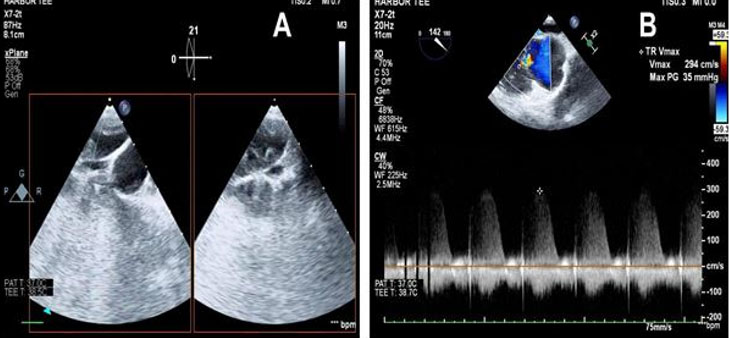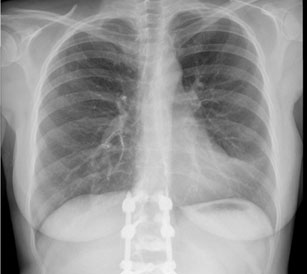 |
Case Report
Trochlear nerve palsy with subarachnoid hemorrhage in ambient cistern
1 MD, Director, Department of Neurosurgery, Hokuto Hospital, Obihiro, Hokkaido, Japan
Address correspondence to:
Akira Tempaku
7-5 Inada-cho-kisen, Obihiro, Hokkaido 080-0833,
Japan
Message to Corresponding Author
Article ID: 100078Z09AT2025
Access full text article on other devices

Access PDF of article on other devices

How to cite this article
Tempaku A. Trochlear nerve palsy with subarachnoid hemorrhage in ambient cistern. J Case Rep Images Med 2025;11(1):1–4.ABSTRACT
Introduction: Subarachnoid hemorrhage in the perimesencephalic cistern is usually of unknown etiology. It is diagnosed by headache or signs of meningeal irritation, which are rarely accompanied by impaired consciousness or central nervous system disturbances, including cranial nerve palsies. The author reports a case of subarachnoid hemorrhage in the perimesencephalic cistern showing ipsilateral trochlear nerve palsy with sudden onset of headache.
Case Report: A 66-year-old man presented headache with diplopia. Neurological examination, including Bielschowsky head-tilt test revealed left isolated trochlear nerve palsy, without any other central nerve system disorders. Magnetic resonance image revealed subarachnoid hemorrhage at the left ambient cistern. The mass of dense hematoma clot in the ambient cistern brought to ipsilateral trochlear nerve palsy. Neural dysfunction improved with following hematoma disappearance.
Conclusion: It is a rare case of isolated trochlear nerve palsy associated with perimesencephalic subarachnoid hemorrhage.
Keywords: Ambient cistern, Bielschowsky head-tilt test, Subarachnoid hemorrhage, Trochlear nerve palsy
Introduction
A patient with diplopia diagnosed to left trochlear nerve palsy, following to sudden onset of subarachnoid hemorrhage (SAH). Magnetic resonance image (MRI) revealed a localized hematoma in the left ambient cistern. The dense hematoma clot occupied to the narrow space of the cistern running through the trochlear nerve fiber. Here is a rare case presentation of isolated trochlear nerve palsy with perimesencephalic SAH. Trochlear nerve is very thin fiber and goes through narrow space at perimesencephalic cistern. Slight mass easily compresses and injures trochlear nerve.
Case Report
A 66-year-old man had sudden onset headache, followed to the double vision. He had been suffering from mental retardation for several years and dyslipidemia, without hypertension, nor diabetes mellitus. He had no history of head trauma. Blood pressure was 151/91 mmHg and heart rate was 90 beats/min. No neurological deficits were identified other than abnormal eye movement. Neck stiffness was not obvious. No motor or sensory disturbances were presented in all extremities and body trunk. Double vision was in the form of vertical diplopia, which increased with downward and rightward gaze. Bielschowsky head-tilt test was positive on left. Clinical symptoms were consistent with left trochlear nerve palsy.
Head magnetic resonance imaging (MRI) indicated SAH in the form of a low-intensity lesion on T2-weighted and T2*-weighted images, high-intensity lesion on flow attenuated inversion recovery (FLAIR) imaging in the left ambient cistern. No evidence of any contusion, abnormal occupation, or vascular anomaly was apparent within the midbrain. Neural degeneration was also not observed in brain stem. No hematoma distributed at quadrigeminal or inter peduncle cistern, Head computed tomography (CT) showed a localized high-density lesion in the left ambient cistern (Figure 1). Cerebral angiography and CT angiography showed no aneurysm, arterial-venous shunt, dissected vertebral-basilar artery, or other vascular abnormality in perimesencephalic cistern. Venous drainage surrounding the basal cistern was normal. Etiology unknown perimesencephalic SAH was diagnosed.
The medical treatment was taken to prevent rebleeding by blood pressure control with calcium blocker administration. Hemostatic agent was injected, intravenously. Following to hematoma diminished, restricted eye ball movement and double vision gradually improved.
Discussion
Isolated trochlear nerve palsy is caused by head trauma [1],[2],[3], ischemic [4],[5] or hemorrhagic stroke [4],[6],[7],[8],[9], tumor [10], and demyelinated nerve disorders [11]. Association of SAH with trochlear nerve palsy is rare [12],[13]. This perimesencephalic SAH case usually has no neurological signs, such as tinnitus or hemi-numbness. In this case, the trochlear nerve was compressed directly by hematoma in ambient cistern and the function of left superior oblique muscle was compromised.
The trochlear nerve has decussation at the quadrigeminal cistern. If the nucleus of the trochlear nerve or intramedullary fiber in mid brain are damaged, contralateral superior oblique muscle palsy would be observed. In contrast, trochlear nerve fiber in subarachnoid space after decussation is injured, ipsilateral palsy would be brought. Cranial nerve palsy with SAH usually derives from the compression of the neural fiber by the enlarged aneurysm. Optic nerve or oculomotor is well known to be influenced with aneurysmal compression. Hematoma in subarachnoid space rarely influences to the cranial nerve function [12],[14].
Cranial nerve palsy is brought to the osmotic pressure of the surrounding hematoma [13], the neurotoxic effects of packed blood cells degradation products [15], or ischemic result from the compression of the neurotrophic vessels of the nerve fibers [16]. The trochlear nerve is known much sensitive to intracranial pressure change or hemorrhagic compression because it is the finest cranial nerve and takes a long course in perimesencephalic cistern. In this case, the hematoma clot on the left ambient cistern was enough to damage the left trochlear nerve palsy.
In contrast, the amount of hematoma in this case was not enough to bring the increased intracranial pressure, brain edema or hydrocephalus, those are reported to cause post SAH cranial nerve disorders [13]. Ischemic change by vasospasm associates to the cranial nerve palsy indirect way [17]. The trochlear nerve is also affected by the same manner [17],[18]. In this case, however, the simultaneous onset of trochlear nerve palsy with SAH and the absence of other neurological disorders denied the possibility of vasospasm and ischemic caused deficiency.
Isolated trochlear nerve palsy usually presents a good recovery [19]. Spontaneous regression is expected within half year [20]. In this case, trochlear nerve palsy seemed to be brought from the nerve fiber compression by hematoma in the narrow space of ambient cistern. However, the palsy persisted more than three weeks, when obvious hematoma was disappeared. Subacute phase dysfunction might be caused to the neurotoxic degeneration by hematoma degradation products [15],[16].
Surgical intervention is rarely applicable since their etiology is almost unknown. However, perimesencephalic SAH is usually good prognosis without neurological deficit. A dense hematoma in perimescencephalic subarachnoid cistern sometimes cause to isolated trochlear nerve palsy, which takes long time to get recovery. Appropriate diagnosis and prompt intervention including rehabilitation would be required.
Conclusion
Perimesencephalic SAH is usually good prognosis. Isolated trochlear nerve palsy is a rare neurological symptom associated with SAH in perimesencephalic cistern. Compression caused by subarachnoid space hematoma impaired the trochlear nerve. Neurological examination and radiographic diagnosis need to clarify the pathophysiology.
REFERENCES
1.
Hara N, Kan S, Simizu K. Localization of post-traumatic trochlear nerve palsy associated with hemorrhage at the subarachnoid space by magnetic resonance imaging. Am J Ophthalmol 2001;132(3):443–5. [CrossRef]
[Pubmed]

2.
Jin H, Wang S, Hou L, et al. Clinical treatment of traumatic brain injury complicated by cranial nerve injury. Injury 2010;41(9):918–23. [CrossRef]
[Pubmed]

3.
Ko YS, Yang HJ, Son YJ, Park SB, Lee SH, Chung YS. Delayed trochlear nerve palsy following traumatic subarachnoid hemorrhage: Usefulness of high-resolution three dimensional magnetic resonance imaging and unusual course of the nerve. Korean J Neurotrauma 2018;14(2):129–33. [CrossRef]
[Pubmed]

4.
Thömke F, Ringel K. Isolated superior oblique palsies with brainstem lesions. Neurology 1999;53(5):1126–7. [CrossRef]
[Pubmed]

5.
Walsh RA, Murphy RP, Moore DP, McCabe DJH. Isolated trochlear infarction: An uncommon cause of acquired diplopia. Arch Neurol 2010;67(7):892–3. [CrossRef]
[Pubmed]

6.
Chen CH, Hwang WJ, Tsai TT, Lai ML. Midbrain hemorrhage presenting with trochlear nerve palsy. Zhonghua Yi Xue Za Zhi (Taipei) 2000;63(2):138–43.
[Pubmed]

7.
Galetta SL, Balcer LJ. Isolated fourth nerve palsy from midbrain hemorrhage: Case report. J Neuroophthalmol 1998;18(3):204–5.
[Pubmed]

8.
Lee SH, Park SW, Kim BC, Kim MK, Cho KH, Kim JS. Isolated trochlear palsy due to midbrain stroke. Clin Neurol Neurosurg 2010;112(1):68–71. [CrossRef]
[Pubmed]

9.
Raghavendra S, Vasudha K, Shankar SR. Isolated trochlear nerve palsy with midbrain hemorrhage. Indian J Ophthalmol 2010;58(1):66–7. [CrossRef]
[Pubmed]

10.
Lekskul A, Wuthisiri W, Tangtammaruk P. The etiologies of isolated fourth cranial nerve palsy: A 10-year review of 158 cases. Int Ophthalmol 2021;41(10):3437–42. [CrossRef]
[Pubmed]

11.
Jacobson DM, Moster ML, Eggenberger ER, Galetta SL, Liu GT. Isolated trochlear nerve palsy in patients with multiple sclerosis. Neurology 1999;53(4):877–9. [CrossRef]
[Pubmed]

12.
Son S, Park CW, Yoo CJ, Kim EY, Kim JM. Isolated, contralateral trochlear nerve palsy associated with a ruptured right posterior communicating artery aneurysm. J Korean Neurosurg Soc 2010;47(5):392–4. [CrossRef]
[Pubmed]

13.
Adachi K, Hironaka K, Suzuki H, Oharazawa H. Isolated trochlear nerve palsy with perimesencephalic subarachnoid haemorrhage. BMJ Case Rep 2012;2012:bcr2012006175. [CrossRef]
[Pubmed]

14.
Rush JA, Younge BR. Paralysis of cranial nerves III, IV, and VI. Cause and prognosis in 1,000 cases. Arch Ophthalmol 1981;99(1):76–9. [CrossRef]
[Pubmed]

15.
Kamp MA, Dibué M, Etminan N, Steiger HJ, Schneider T, Hänggi D. Evidence for direct impairment of neuronal function by subarachnoid metabolites following SAH. Acta Neurochir (Wien) 2013;155(2):255–60. [CrossRef]
[Pubmed]

16.
Hoya K, Kirino T. Traumatic trochlear nerve palsy following minor occipital impact—Four case reports. Neurol Med Chir (Tokyo) 2000;40(7):358–60. [CrossRef]
[Pubmed]

17.
Laun A, Tonn JC. Cranial nerve lesions following subarachnoid hemorrhage and aneurysm of the circle of Willis. Neurosurg Rev 1988;11(2):137–41. [CrossRef]
[Pubmed]

18.
Mansour AM, Reinecke RD. Central trochlear palsy. Surv Ophthalmol 1986;30(5):279–97. [CrossRef]
[Pubmed]

19.
Richards BW, Jones FR Jr, Younge BR. Causes and prognosis in 4,278 cases of paralysis of the oculomotor, trochlear, and abducens cranial nerves. Am J Ophthalmol 1992;113(5):489–96. [CrossRef]
[Pubmed]

20.
Mollan SP, Edwards JH, Price A, Abbott J, Burdon MA. Aetiology and outcomes of adult superior oblique palsies: A modern series. Eye (Lond) 2009;23(3):640–4. [CrossRef]
[Pubmed]

SUPPORTING INFORMATION
Author Contributions
Akira Tempaku - Conception of the work, Design of the work, Acquisition of data, Analysis of data, Drafting the work, Revising the work critically for important intellectual content, Final approval of the version to be published, Agree to be accountable for all aspects of the work in ensuring that questions related to the accuracy or integrity of any part of the work are appropriately investigated and resolved.
Guaranter of SubmissionThe corresponding author is the guarantor of submission.
Source of SupportNone
Consent StatementWritten informed consent was obtained from the patient for publication of this article.
Data AvailabilityAll relevant data are within the paper and its Supporting Information files.
Conflict of InterestAuthor declares no conflict of interest
Copyright© 2025 Akira Tempaku. This article is distributed under the terms of Creative Commons Attribution License which permits unrestricted use, distribution and reproduction in any medium provided the original author(s) and original publisher are properly credited. Please see the copyright policy on the journal website for more information.






